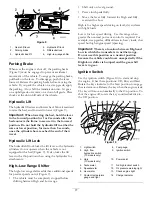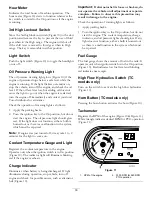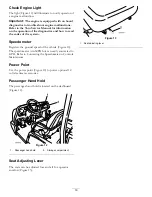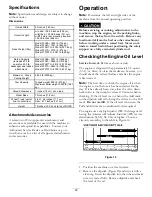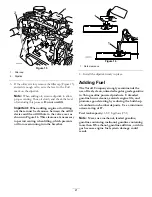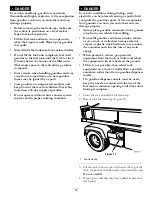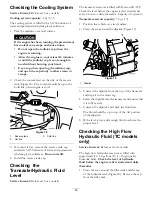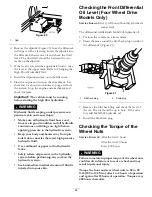
Note:
These tires are different than car tires, they
require less pressure to minimize turf compaction
and damage.
•
Check all fluid levels and add the appropriate
amount of Toro specified fluids, if any are found
to be low.
•
Check the front of the radiator. Remove any debris
and clean the radiator screen.
•
Check the brake pedal operation.
•
Check to see that the lights are working.
•
Turn the steering wheel to the left and right to
check the steering response.
•
Stop the engine and wit for moving parts to stop,
then check for oil leaks, loose parts, and any other
noticeable malfunctions.
If any of the above items are not correct, notify your
mechanic or check with your supervisor before taking
the vehicle out for the day. Your supervisor may want
you to check other items on a daily basis, so ask what
your responsibilities are.
Starting the Engine
1. Sit on the operator’s seat and engage the parking
brake.
2. Disengage the PTO and high flow hydraulics (if so
equipped) and move the hand throttle lever to the
Off position (if so equipped).
3. Move the shift lever to the Neutral position and
press the clutch pedal.
4. Ensure that the hydraulic lift lever is in the center
position.
5. Keep your foot off of the accelerator pedal.
Note:
If the engine is
flooded
—fully press the
accelerator pedal and hold it to the floor until the
engine starts. Never pump the accelerator pedal.
6. Insert key into ignition switch and rotate it clockwise
to start the engine. Release key when engine starts.
Important:
To prevent overheating of the
starter motor, do not engage starter longer than
15 seconds. After 15 seconds of continuous
cranking, wait 60 seconds before engaging
starter motor again.
Driving the Vehicle
1. Release the parking brake.
2. Fully press the clutch pedal.
3. Move the gear shift lever to 1st gear.
4. Release the clutch pedal smoothly while pressing
the accelerator pedal.
5. When the vehicle gains enough speed, remove your
foot from the accelerator pedal, fully press the
clutch pedal, move the gear shift lever to the next
gear and release the clutch pedal while pressing the
accelerator pedal. Repeat the procedure until the
desired speed is attained.
Important:
Always stop the vehicle before
shifting to reverse a forward gear or to a forward
gear from reverse.
Note:
Avoid long periods of engine idling.
Use the chart below to determine the ground speed
of the vehicle at 3600 RPM.
Gear
Range
Ratio
Speed
(mph)
Speed
(kmh)
1
L
82.83 : 1
2.9
4.7
2
L
54.52 : 1
4.5
7.2
3
L
31.56 : 1
7.7
12.5
1
H
32.31 : 1
7.6
12.2
2
H
21.27 : 1
11.5
18.5
3
H
12.31 : 1
19.8
31.9
R
L
86.94 : 1
2.8
4.5
R
H
33.91 : 1
7.1
11.6
Note:
Leaving ignition switch in the On position
for long periods of time without running the engine
will discharge the battery.
Important:
Do not attempt to push or tow
vehicle to get it started. Damage to the drive
train could result.
Stopping the Vehicle
To stop the vehicle, remove your foot from the
accelerator pedal, press the clutch pedal, then press the
brake pedal.
Stopping the Engine
To stop the engine, rotate the ignition key to the Off
position and engage the parking brake. Remove the key
from the switch to prevent accidental starting.
New Vehicle Break–in
Your Workman is ready for work. To provide proper
performance and long vehicle life, follow these
guidelines for the first 100 operating hours.
26
Summary of Contents for 07367TC
Page 41: ...Figure 44 41...
Page 60: ...Schematics Hydraulic Schematic Rev B High Flow Hydraulics Schematic TC models only Rev A 60...
Page 61: ...Electrical Schematic Rev B 61...
Page 62: ...Notes 62...
Page 63: ...Notes 63...






